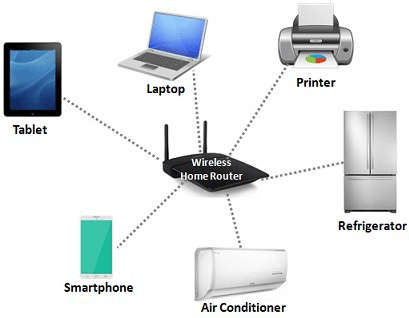Advantages and Disadvantages of the LAN – Javatpoint
← prev
Mục Lục
Advantages and Disadvantages of the LAN
The Full form of the LAN is the Local Area Network. It is a collection of devices interlinked to a single physical location, such as a home building or office. LAN could be tiny or big, varying from the home network to enterprise network having hundreds of users and devices in school or office. The total area covered under LAN would be around 1 to 10 kilometres. The data can be transmitted at the speed of 1-10Mbps.

What is a Local Area Network (LAN)?
It consists of routers, access points, cables, and other devices to connect to internal servers, web servers, and other LANs through wide area networks. Exponential growth in the information economy has significantly boosted the development of Virtual LANs that enable network administrators to logically group network nodes and partition their networks without significant infrastructure.
For example, there are multiple departments in an office building like IT support, accounting, and administration. Computers of each department could be connected to the same switch and can be behaved differently.
Working of the LAN
Most LANs are linked to the Internet at a central point: a router; Home LANs conventionally use a single router, while LANS in larger areas may opt for additional network switches for more efficient delivery.
They use Wi-Fi, Ethernet, or both in pursuit of linking devices within the network. Wi-Fi is a protocol for connecting to a network through radio waves. Ethernet is a protocol for physical network connections that use ethernet cables.
Several devices can be connected to LANs, including IoT devices, desktop computers, servers, printers, laptops, and game consoles. LANs normally offer shared access to internal staff to connect to servers or printers.
Devices Needed to Set Up a LAN
Internet-connected LANs require only a router and a path for computing devices to connect to the router through Ethernet cables or a Wi-Fi hotspot. LAN requires a switch to exchange information in the absence of the Internet. Big LANs in the offices may require additional routers or switches so that the data can move swiftly and efficiently.
However, not all LANs are connected to the Internet. The only precondition is to form LAN that is connected devices able to exchange information smoothly. Non-internet-connected LANs use the same networking protocol that is used on the Internet.
Virtual LAN
Sometimes, it is referred to as VLANS, splitting traffic on the same physical network into two networks. For a moment, think about installing two different LANs with their router and internet connection in the same room, but in the VLAN, it is performed in a virtual mode with the help of software instead of using physical hardware. Here, only one router and one internet connection are required.
It helps with network management, particularly with huge LANs. With the subdivision of networks, Administrators can manage networks more smoothly.
Advantages and Disadvantages of LAN
- Simple and Inexpensive: The main benefit of the Local Area Network is that it is prompt and easy to set up at a comparatively low price. If an organisation wishes to construct a network at a low price and with flexibility, a Local area network would be an ideal choice.
- Accessible Software: Programs can also be shared on the Local Area Network. Incorporate a single licensed program, and any device can use it on a network.
- Rapid Communication: LAN-interlinked devices transfer files and communicate directly and rapidly based on the LAN model and ethernet cabling installed. They work on 1000 Mbps, 100 Mbps, and 10 Mbps. Gigabit Ethernet technologies are developing quickly. If this technology becomes sophisticated and large-scale production, lower-cost variants will be accessible to the public.
- Association of Client and Server: All the company-related information is kept on a single server. If a client asks for the information, the client can access it seamlessly.
- Collaboration of Resources: Components that are expensive, like scanners and printers, cannot be connected to every device in the office, and it will become a burdensome task for the organization, but in a LAN, there is a requirement of one printer and scanner, and everyone can be connected, and they have to send instructions from their respective machines. This will save the cost and time of the employee.
- Protection of the Data: In cybercrime, all organizations want their data to be kept safe. LAN is an ideal place where you can keep your data safe. Suppose a client wishes to improve, update, and delete data. In that case, they can log into a single server computer, and other devices will automatically receive their information. It has the option to give to whom the user wishes to give access to the particular file. Only approved users can access those files.
- File Locking: LAN allows file locking in its network.
Disadvantages of the LAN
- Weak Protection of Data: Unauthorised users can access the file if the server has not been properly programmed. Due to this, the frequent glitch is observed.
- Maximum Damage: If the device, file, or server crashes, it affects the whole network.
- Installation Charge is Expensive: Installing a LAN is expensive, as it requires specialized software to install a server. Equipment like cables, routers, and switches are very expensive. A professional operator is required to troubleshoot and administer a huge office like LAN.
- Malware: Malware can easily penetrate the LAN, corrupt the whole network, and destroys important data.
- Maintenance: LAN requires frequent maintenance and the involvement of technicians and system operators.
- Space Problem: The software of the LAN requires a memory area in each of the mainframes used on the network. It minimized the space required for the user’s program.
Next Topic
Advantages and Disadvantages of Asexual Reproduction
← prev
next →















![Toni Kroos là ai? [ sự thật về tiểu sử đầy đủ Toni Kroos ]](https://evbn.org/wp-content/uploads/New-Project-6635-1671934592.jpg)


